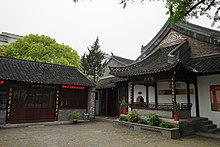|
Crane Mosque
Crane Mosque, also known by its Chinese name as the Xianhe Mosque and by other names, is a mosque located in Yangzhou, Jiangsu, China.
NamesThe English name Crane Mosque is a partial calque of its Chinese name 仙鶴寺, pronounced Xiānhè Sì in Mandarin. The name is sometimes explained by the supposed resemblance of the mosque's shape to a crane,[1][2] although the Chinese name references a Taoist immortal. As the most historically important mosque in the city, it is also known as the Yangzhou Mosque and as the Qingbai Liufang Mosque.[citation needed] HistoryCrane Mosque was supposedly built in 1275[dubious – discuss] by the Arab Muslim Puhaddin, a 16th-generation descendant of Muhammad,[3][1][2][4] the year after his death[5] and the year before the Mongol general Bayan received the surrender of Yangzhou following Li Tingzhi's execution by the Southern Song.[6][7] The mosque was severely damaged during the Red Turban Rebellion that ended the Mongolian Yuan dynasty. An Arab Muslim named Hasan[which?] rebuilt the mosque in 1390 under the early Ming.[citation needed] It was further renovated and refurbished in 1523 under the Jiajing Emperor.[citation needed] The Crane Mosque is accounted as one of the Four Great Mosques of China—alongside the Huaisheng, Qingjing, and Phoenix Mosques in Guangzhou, Quanzhou, and Hangzhou[3][1][2][4]—and was inscribed as a cultural relic protected by the Jiangsu government in April 1995.[citation needed] It now includes a small collection of documents concerning China's relations with Muslim countries.[8] ReferencesCitations
Bibliography
External links
Wikimedia Commons has media related to Crane Mosque.
|
||||||||||||||||||||||||||||||||||||||||||||||||||||||||||||||||||
Portal di Ensiklopedia Dunia

